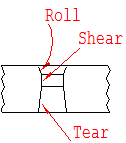
|
NIBBLING: Techniques and Tool 333Options |
|
To Nibble means to take repeated bites (to not punch with all edges of a punch). Edge life on tools used for nibbling will wear more quickly than tools used for piercing. |
|
Example of Bridge Hits |
|
Example of 75% Nibble Hits |
|
Example of Incorrect Nibble Hit |
|
Not a 75% Bite |
|
It is a tendency of a punch used for nibbling to side load which can cause the punch to shear against the die’s cutting edge. When you pierce a hole, the punch tip follows into the center of the mating die as it takes the easiest path to pierce through the sheet. When you nibble, the punch can float side ways to an extent allowed by play inherent of all turret punch presses.
|

|
2nd: Punches can be ordered with Inverted Shears (1/32-1/8 deep depending on tooling style). A shear on a punch does a few things. We initially suggest inverted shears for nibbling as the heel on the punch centers the tool when performing a Bridge hit and when taking a nibble bite with only a portion of the punch face, the rectangle pad on the side of the punch shear imbeds itself into the material helping to prevent the punch from side loading and shearing on the die. Another feature of the shear is to reduce the tonnage required (reference page 6). Lastly, the shear on the punch helps prevent slug pulling. A shear prevents the slug from suctioning on the face of a punch. This is a result created when a flat faced punch presses tightly against the sheet squeezing all the air out between itself and the pending slug. Further, the slug is kinked from the punch shear, making the slugs shape hug tightly to the sides of the die land. 3rd: For nibbling, extend die clearance by up to 50%. Example, if our chart on Page 4 calls out .008, move up to .012 clearance. This extra clearance allows more room for the punch to flex sideways before it can shear on the side of the die. The negative to increasing the die clearance is it opens up more possibilities to slug pulling. Tighter clearances reduces slug pulling and higher hole quality. Opening up clearances greatly extends tool edge life but can cause slug pulling problems and larger hole burr. 4th: Punches can be ordered with heels. A heel on a punch will extend past the standard length of the punch by 3/16-1/4”. The heel enters into the die prior to punching extending ridged support and alignment. (Prevents punch from shearing on to die edge.) |
|
Standard punches and dies (ref. page 4 for clearances) can be used for nibbling and extend good edge life. Depending on your companies specific requirements and fabrication goals, there are techniques and tool options to extend greater tool life when nibbling. Read through the below and keep in mind there will often be a pro and a con to each option or technique . 1st : And most important, carefully program hits to prevent tools from side loading! Program bridge hits or take nibble bites of no less than 75% of punch area. Not following these rules even for 1 or 2 hits can cause side load pressure to the punch in which the cutting edge may make contact with die causing instant edge break down! |
|
Explanation :The 1st 25% of penetration of punch tip into a sheet merely stretches the material (no cutting). This is the section of the stroke were much of the side pressure onto the punch tip comes from as the path of least resistance is sought. (Ex. a .200X1” punch taking a bite (suggest 75% of punch surface) which cuts on only 3 sides will be pushed sideways towards the edge of punch which is not cutting.) The next roughly 35% of penetration does in fact cut (shear). If side pressure has started, the side of punch not cutting may continue it’s side pressure causing the punch to shear on the cutting edge of the die. The remaining 40% penetration through the sheet actually tears. (These percentages are rough estimates as material type and clearance plays an important factor.) |
